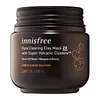What's inside
What's inside
 Key Ingredients
Key Ingredients

 Benefits
Benefits

 Concerns
Concerns

 Ingredients Side-by-side
Ingredients Side-by-side

Aloe Barbadensis Leaf Juice
Skin ConditioningPalau White Clay
HumectantAgathis Australis Resin
Glycerin
HumectantOryza Sativa Bran Oil
EmollientHelianthus Annuus Seed Oil
EmollientRicinus Communis Seed Oil
MaskingBetaine
HumectantCetearyl Olivate
Potassium Palmitate
EmulsifyingTerminalia Ferdinandiana Fruit Extract
AntioxidantSorbitan Olivate
EmulsifyingGlyceryl Stearate
EmollientCetearyl Alcohol
EmollientHydrolyzed Wheat Protein
Skin ConditioningMicrocitrus Australis Fruit Extract
Skin ConditioningMicrocitrus Australasica Fruit Extract
Citrus Glauca Fruit Extract
HumectantGluconolactone
Skin ConditioningSodium Benzoate
MaskingCalcium Gluconate
HumectantXanthan Gum
EmulsifyingCitric Acid
BufferingAloe Barbadensis Leaf Juice, Palau White Clay, Agathis Australis Resin, Glycerin, Oryza Sativa Bran Oil, Helianthus Annuus Seed Oil, Ricinus Communis Seed Oil, Betaine, Cetearyl Olivate, Potassium Palmitate, Terminalia Ferdinandiana Fruit Extract, Sorbitan Olivate, Glyceryl Stearate, Cetearyl Alcohol, Hydrolyzed Wheat Protein, Microcitrus Australis Fruit Extract, Microcitrus Australasica Fruit Extract, Citrus Glauca Fruit Extract, Gluconolactone, Sodium Benzoate, Calcium Gluconate, Xanthan Gum, Citric Acid
Water
Skin ConditioningCI 77891
Cosmetic ColorantButylene Glycol
HumectantSilica
AbrasiveGlycerin
HumectantTrehalose
HumectantVolcanic Ash
AbrasivePolyvinyl Alcohol
Bentonite
AbsorbentKaolin
AbrasiveCaprylic/Capric Triglyceride
MaskingGlyceryl Stearate
EmollientStearic Acid
CleansingCetearyl Alcohol
EmollientPvp
Emulsion Stabilising1,2-Hexanediol
Skin ConditioningPEG-100 Stearate
Polysorbate 60
EmulsifyingCI 77499
Cosmetic ColorantHydrogenated Vegetable Oil
EmollientXanthan Gum
EmulsifyingJuglans Regia Shell Powder
AbrasiveSorbitan Stearate
EmulsifyingZea Mays Starch
AbsorbentPolyacrylate-13
Polysorbate 20
EmulsifyingCI 77492
Cosmetic ColorantMannitol
HumectantMicrocrystalline Cellulose
AbsorbentLactic Acid/Glycolic Acid Copolymer
Skin ConditioningLactic Acid
BufferingPolyisobutene
CI 77491
Cosmetic ColorantMenthoxypropanediol
MaskingTetrasodium Pyrophosphate
BufferingDisodium EDTA
Ethylhexylglycerin
Skin ConditioningSorbitan Isostearate
EmulsifyingAluminum Hydroxide
EmollientTriethoxycaprylylsilane
Tocopherol
AntioxidantWater, CI 77891, Butylene Glycol, Silica, Glycerin, Trehalose, Volcanic Ash, Polyvinyl Alcohol, Bentonite, Kaolin, Caprylic/Capric Triglyceride, Glyceryl Stearate, Stearic Acid, Cetearyl Alcohol, Pvp, 1,2-Hexanediol, PEG-100 Stearate, Polysorbate 60, CI 77499, Hydrogenated Vegetable Oil, Xanthan Gum, Juglans Regia Shell Powder, Sorbitan Stearate, Zea Mays Starch, Polyacrylate-13, Polysorbate 20, CI 77492, Mannitol, Microcrystalline Cellulose, Lactic Acid/Glycolic Acid Copolymer, Lactic Acid, Polyisobutene, CI 77491, Menthoxypropanediol, Tetrasodium Pyrophosphate, Disodium EDTA, Ethylhexylglycerin, Sorbitan Isostearate, Aluminum Hydroxide, Triethoxycaprylylsilane, Tocopherol
 Reviews
Reviews

Ingredients Explained
These ingredients are found in both products.
Ingredients higher up in an ingredient list are typically present in a larger amount.
Cetearyl alcohol is a mixture of two fatty alcohols: cetyl alcohol and stearyl alcohol. It is mainly used as an emulsifier. Emulsifiers help prevent the separation of oils and products. Due to its composition, it can also be used to thicken a product or help create foam.
Cetearyl alcohol is an emollient. Emollients help soothe and hydrate the skin by trapping moisture.
Studies show Cetearyl alcohol is non-toxic and non-irritating. The FDA allows products labeled "alcohol-free" to have fatty alcohols.
This ingredient is usually derived from plant oils such as palm, vegetable, or coconut oils. There is debate on whether this ingredient will cause acne.
Due to the fatty acid base, this ingredient may not be Malassezia folliculitis safe.
Learn more about Cetearyl AlcoholGlycerin is already naturally found in your skin. It helps moisturize and protect your skin.
A study from 2016 found glycerin to be more effective as a humectant than AHAs and hyaluronic acid.
As a humectant, it helps the skin stay hydrated by pulling moisture to your skin. The low molecular weight of glycerin allows it to pull moisture into the deeper layers of your skin.
Hydrated skin improves your skin barrier; Your skin barrier helps protect against irritants and bacteria.
Glycerin has also been found to have antimicrobial and antiviral properties. Due to these properties, glycerin is often used in wound and burn treatments.
In cosmetics, glycerin is usually derived from plants such as soybean or palm. However, it can also be sourced from animals, such as tallow or animal fat.
This ingredient is organic, colorless, odorless, and non-toxic.
Glycerin is the name for this ingredient in American English. British English uses Glycerol/Glycerine.
Learn more about GlycerinGlyceryl Stearate is a mix of glycerin and stearic acid.
It is used to stabilize the mixing of water and oil ingredients. By preventing these ingredients from separating, it can help elongate shelf life. It can also help thicken the product's texture.
As an emollient, it helps soften skin and supports barrier-replenishing ingredients.
In cosmetics, Glyceryl Stearate is often made from vegetable oils or synthetically produced.
This ingredient may not be fungal-acne safe
Fun fact: The human body also creates Glyceryl Stearate naturally.
Learn more about Glyceryl StearateXanthan gum is used as a stabilizer and thickener within cosmetic products. It helps give products a sticky, thick feeling - preventing them from being too runny.
On the technical side of things, xanthan gum is a polysaccharide - a combination consisting of multiple sugar molecules bonded together.
Xanthan gum is a pretty common and great ingredient. It is a natural, non-toxic, non-irritating ingredient that is also commonly used in food products.
Learn more about Xanthan Gum